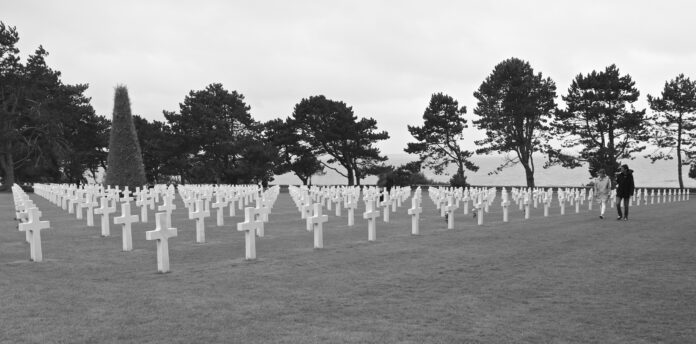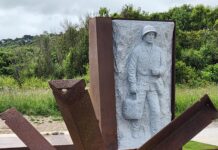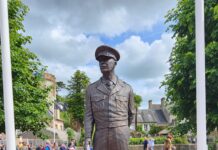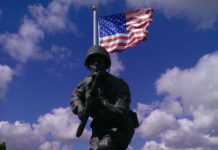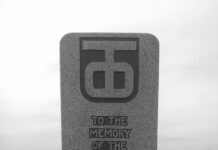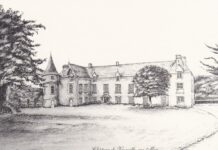Third in a series.
VI
Operation Neptune laid out a carefully organized assault on the beaches. The landing diagram for the 116th Regimental Landing Team (RLT) is found in “Omaha Beachhead” (Washington, D.C.: U.S. War Department, 1945), p. 31) and reproduced in Stephen E. Ambrose, “D-Day” (New York: Simon & Schuster, 1994), pp. 122-23). It illustrates the timing and composition of the orderly progression of landing craft carrying the units assaulting the Dog Green, White, Red and Easy Green of Omaha Beach, the beach sectors between the draws leading up to the villages of Vierville and Colleville. The diagram lays out in meticulous detail the types of landing craft, the units assigned to each wave and the minute that wave was due to reach the beach. It is a perfect example of meticulous military staff work—nothing was left to chance. There was no contingency plan. If any later adjustment were needed, it would have to be made on an ad hoc basis by commanders on the spot. And, this plan fell apart before the GIs executing it made first contact with the enemy.
The 32 Duplex-Drive tanks (American M-4 “Sherman” tanks, cleverly fitted with a pair of small propellers and a canvas dam, that could theoretically swim themselves ashore) of the 743rd Tank Battalion were scheduled to land first at H-Hour minus five minutes on Dog White and Dog Green sectors. They were expected to halt at the high-water line, and then take on any German bunkers and gun emplacements that had survived the 5,316 tons of bombs just unloaded by hundreds of Eighth Air Force heavy bombers and the short, intense naval bombardment from the ships of Task Force O. Most of those DD tanks still lie on the bottom of the Bay of the Seine. Launched from Landing Craft, Tanks (LCTs) too far off shore for the prevailing sea state, most foundered on their run in. Two actually reached the beach on their own. An LCT brought three others into the beach because they could not be launched off shore as planned.
To further complicate the landing, the air and naval bombardments had been ineffective, failing to seriously compromise the German defenses. That left the seasick GIs from Companies A and G of the 116th RCT horribly exposed as their landing craft, launched 10,000 yards off shore, ran aground on sandbars among the scores of mined beach obstacles that Generalfeldmarschall Erwin Rommel, Army Group B commander, had ordered emplaced on the beach when it was exposed at low tide.
Each 30-man boat-section had been carefully organized as a self-sufficient combat team with various 2-4 man squads armed with M-1s, BARs, bangalore torpedoes, mortars, explosives, even a two-man flame thrower team. Based on interviews with the survivors, combat historian S.L.A. Marshall reconstructed the fate of the Virginia National Guardsmen of Company A (about 200 men) as their surviving LCAs grounded on the sandbars off Dog Green. None of the “realistic training” they had undergone could have prepared the “Stonewallers” for what they now faced. Boat #5 foundered a thousand yards off shore; six guardsmen drowned. Boat #3 was hit by German artillery on its run in to the beach, killing another 13 men. Boat #6 was also hit and sank with no survivors. The GIs in the surviving three boats, grounded on the sandbars, could hear machine gun bullets ricocheting off the boat ramps before they were dropped. Half the men in Boats #1 and #4 died in the surf within a few yards of their boats. No unwounded officers or non-coms reached the beach. The shell-shocked survivors huddled behind beach obstacles; others crouched against the low seawall that ran the length of the beach. Company A no longer existed as a fighting unit.
(Riding along in those boats and ones that followed were 34 young Virginians from the small Blue Ridge town of Bedford; 22 died that morning and another four were killed in the days that followed. Only six who rode in on those LCAs survived D-Day. To honor those “Bedford Boys,” The National D-Day Memorial was dedicated in Bedford on June 6, 2001.)
Lt. Cawthon, in an LCA launched from the transport Jefferson, reached the beach a half an hour after the first wave. He remembered the Dog Red sector shrouded in smoke from fires burning on the bluff:
“A haze of smoke, barely darker than the dull morning, was the first sign of the shore, and then the line of bluffs that lay behind the beach began to loom above the Channel waters. Finally, it was all dimly visible, just about the time that our craft shuddered to a halt on a sandbar two hundred or so yards offshore . . . in automatic response to the dropped ramp, we lumbered off in three files—center, right, left—into the cold, shoulder-deep surf. The life belt under my arms lifted me to the crest of an on-rolling wave, and here, flailing around to keep my right side up against a top-heavy load, I caught the first full glimpse of combat, the inner sanctum of war toward which we had struggled so long and painfully.”
What Cawthon saw was a beach littered with disabled and burning landing craft, tanks and the bodies of his fellow Stonewallers; a line of black shapes pressed against the seawall were the survivors of the first waves.
“There is a definite calming effect to the casting of the die,” he later reflected, “and the die had been irrevocably cast on Omaha Beach.”
“The wave passed on,” Cawthon remembered, “and in the trough I touched bottom, to be lifted moments later and carried again toward France. Such was the pattern of my advance in the greatest amphibious assault of history: up wave and down trough, propelled forward by a powerful, in-sweeping tide, regardless of any lessening fervor to open the second front in Europe.” Charles R. Cawthon, Other Clay: A Remembrance of the World War II Infantry (Niwot, CO, University Press of Colorado, 1990).
As Cawthon bobbed toward his beach rendezvous, Brig, Gen. Norman D. (Dutch) Cota, Assistant Division Commander of the 29th ID, and Col. Canham moved among the men crouched behind the seawall further to the east, urging them to leave its illusory protection to undertake the treacherous climb up the bluff. Cota was reported to have told one group of GIs that if they stayed on the beach they would die there. He personally led one group of Stonewallers up the bluffs east of the D-1 draw, and then returned down that draw to the beach to rally those still huddled there. Sgt. Mike Rehm remembered Cota stumbling on his group of Rangers sheltering behind the seawall. “Who are you people,” the general shouted. “Sir, we’re Rangers.” “Goddamit, Cota replied, “if you’re Rangers, get up there and lead the way.”
Don McCarthy, of the 116th Headquarters Company, remembered being more afraid of Col. Canham that morning than of the Germans. Canham, wounded in his right hand, strode up and down the beach firing his .45 with his left, giving the pistol to his runner to reload.
Both Cota and Canham were awarded DSCs for their actions on D-Day.
Another Stonewaller, Russell Stover, who landed with the third wave, found the survivors of the earlier waves stymied by a 20’ wide band of six concertina wire rolls. Not having any bangalore torpedoes because the first waves were to have already blown gaps in the wire, Stover put out a call for any that could be rounded up. Meanwhile, the new arrivals opened up on the bluff with a machine gun, only to be surprised when a destroyer steaming close offshore began firing at the same Kraut positions, suppressing their return fire. The riflemen then blew a gap in the wire with the four bangalores they had found and rushed through the gap. “Some didn’t make it,” Stover laconically remembered in a memoir he wrote for the “Twenty-Niner Newsletter.” (These events were compressed in a scene from Darryl Zanuck’s film “The Longest Day” (1962), in which actor Robert Mitchum portrayed Norman Cota.)
Those destroyers, maneuvering close inshore as the tide came in, provided the fire support sadly missing from the lost DD tanks. USS Satterlee (DD-626) fired some 638 rounds of 5”/38 ammunition at shore targets on Omaha Beach, about average for the tin cans in Force O. (Incidentally, Quartermaster 3rd Class Henry Fonda was serving on Satterlee that morning.) Naval fire support probably saved the day for the 116th RCT landing on Dog Green and the Rangers who assaulted the Pointe du Hoc, a few kilometers further west. However, at Colville, Vierville and Les Moulins, lack of communication (either the naval shore parties were casualties or their radios were) with the destroyers resulted in a number of friendly fire casualties among the GIs who had already driven the Krauts from those villages.
Two minutes behind the Stonewallers and Rangers came the first demolition teams (both Army and Navy) from the 6th Special Engineer Task Force that were given 30 minutes to clear lanes in the rows of beach obstacles before the incoming tide could submerge them. Their LCMs (Landing Craft, Medium) landed ten minutes late and not always where they had intended. They immediately came under intense fire, the result being that only six lanes were fully opened (three others partially opened) and only one lane marked. Casualties among the engineer units ran to forty percent.



